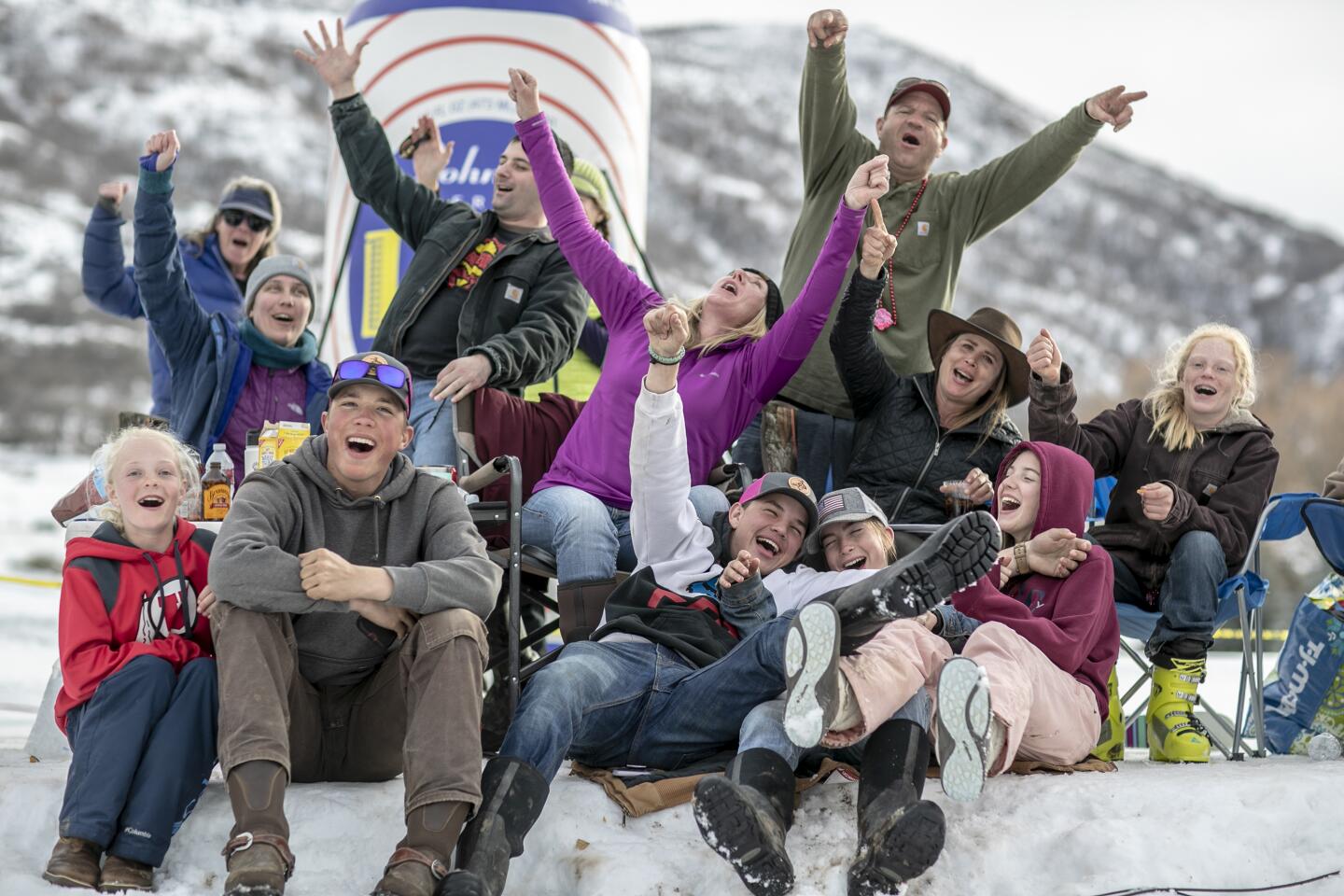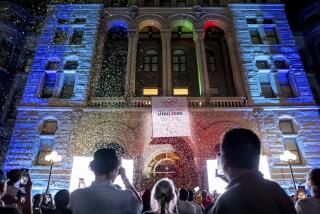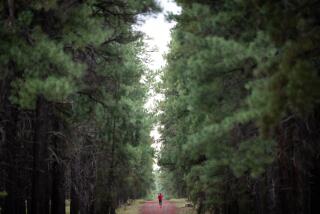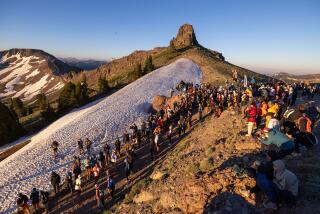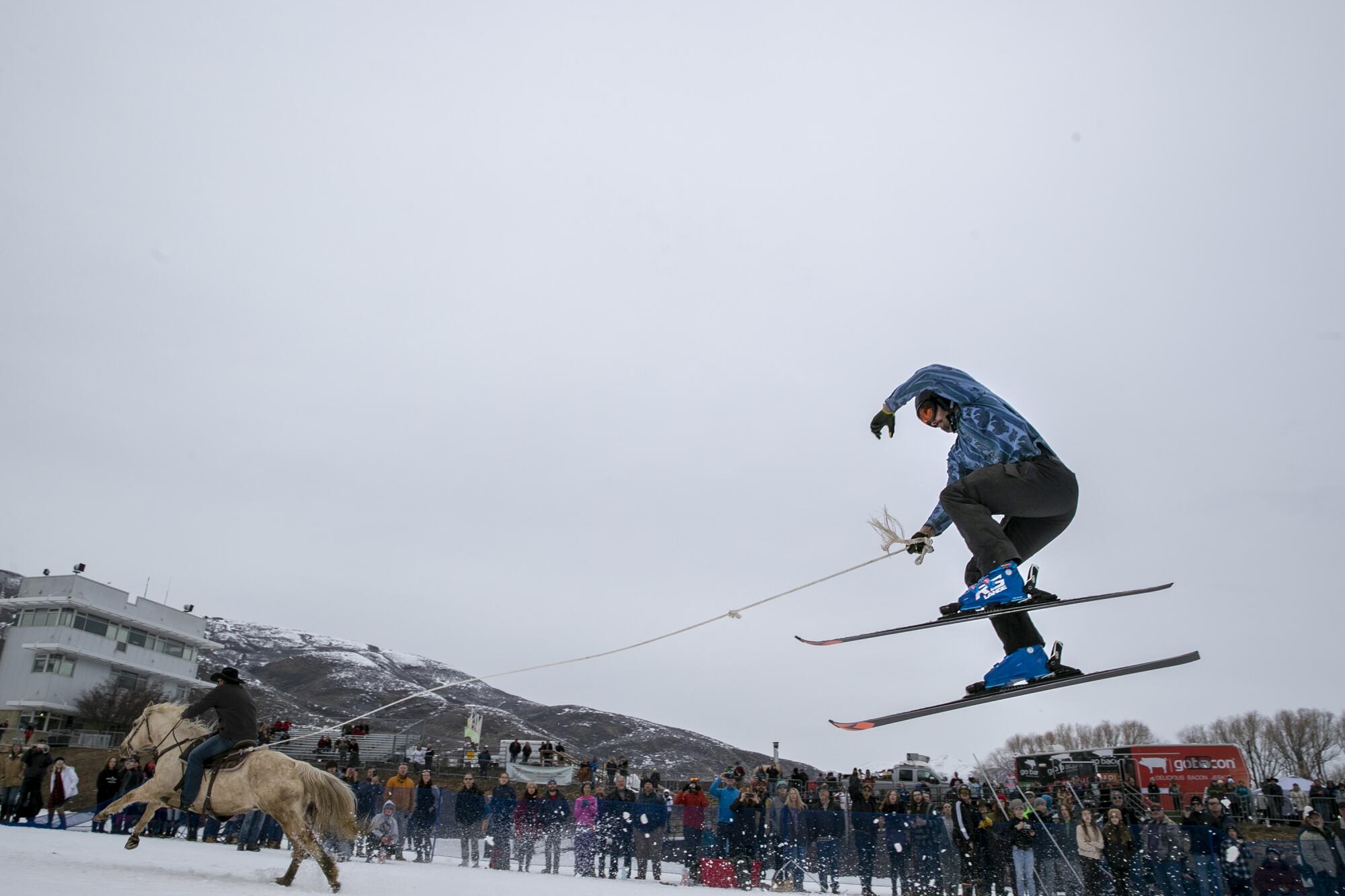
MIDWAY, Utah — Skijoring. It sounds like something Scandinavians might smear on toast.
But it’s actually a niche winter sport, derived from the Norwegian word skikjøring (“ski driving”), that teams up horses (or dogs or motorized vehicles) and skiers for wild rides through snow-packed obstacle courses.
The allure is as simple as a sweaty glass of beer. You take your basic fearless slalom whiz — someone good on the edges — and pull him or her through a timed course with rings to grab and jumps to navigate, at full giddy-up, 40 miles per hour.
The faster, the better, of course. Snow flies. Snot flies. The skier flies. Lots of stuff is flying, and in about 20 seconds the oddball marriage of spurs and snow boots is over.
Rawboned and relatively new, these races are becoming winter traditions in the cowboy states of Montana, Wyoming and here in Utah, near Park City.
“It’s got that perfect absurdity to it,” says spectator Page Blackmore, taking a little sip of cheer to warm the 40-degree day.
There are plenty of silver flasks here in cowboy country, as well as rope burns, back-slaps and belt buckles as big as a dinner plate. Competitors range from first-timers to those who ride the emerging skijoring circuit, with dozens of events in a season.
On the tourney’s first day, Wyatt Rasmussen, 9, fearless and full of little-guy energy, finishes his first run and begins to cry with joy.
“I was so happy,” he explains. “Did you hear me screaming the whole time?”
Wyatt had rehearsed this for five months, on a course he and his siblings built behind the house.
Generally, though, there is no practice for Skijoring Utah, this annual event that draws 250 teams and 5,000 spectators over two days in February. Entry fees range from $75 to $250, depending on skill level, and to plop your beach chair in the snow and just watch costs $15.
The aesthetic is pure cowboy: worn leather, ruddy cheeks, horse blankets, chaps and a Utah winter, with the sheen of butter-brushed pastry.
All in all, skijoring might be the greatest sport you never heard of.
A reindeer game
The modern form of skijoring (pronounced ski-JOOR-ing, with an emphasis on the “joor”) was launched centuries ago, with reindeer — the Norwegian version of a long Uber ride.
Equine skijoring showed up in Lake Placid, N.Y., and Dartmouth College in New Hampshire by 1915. The Olympics nibbled at it in 1928, including it as an exhibition sport at the Games in St. Moritz, Switzerland, where it remains popular.
When U.S. soldiers returned home from World War II, the sport got a boost and started to spread west, where cowboy culture slowly started to embrace it and make it more competitive.
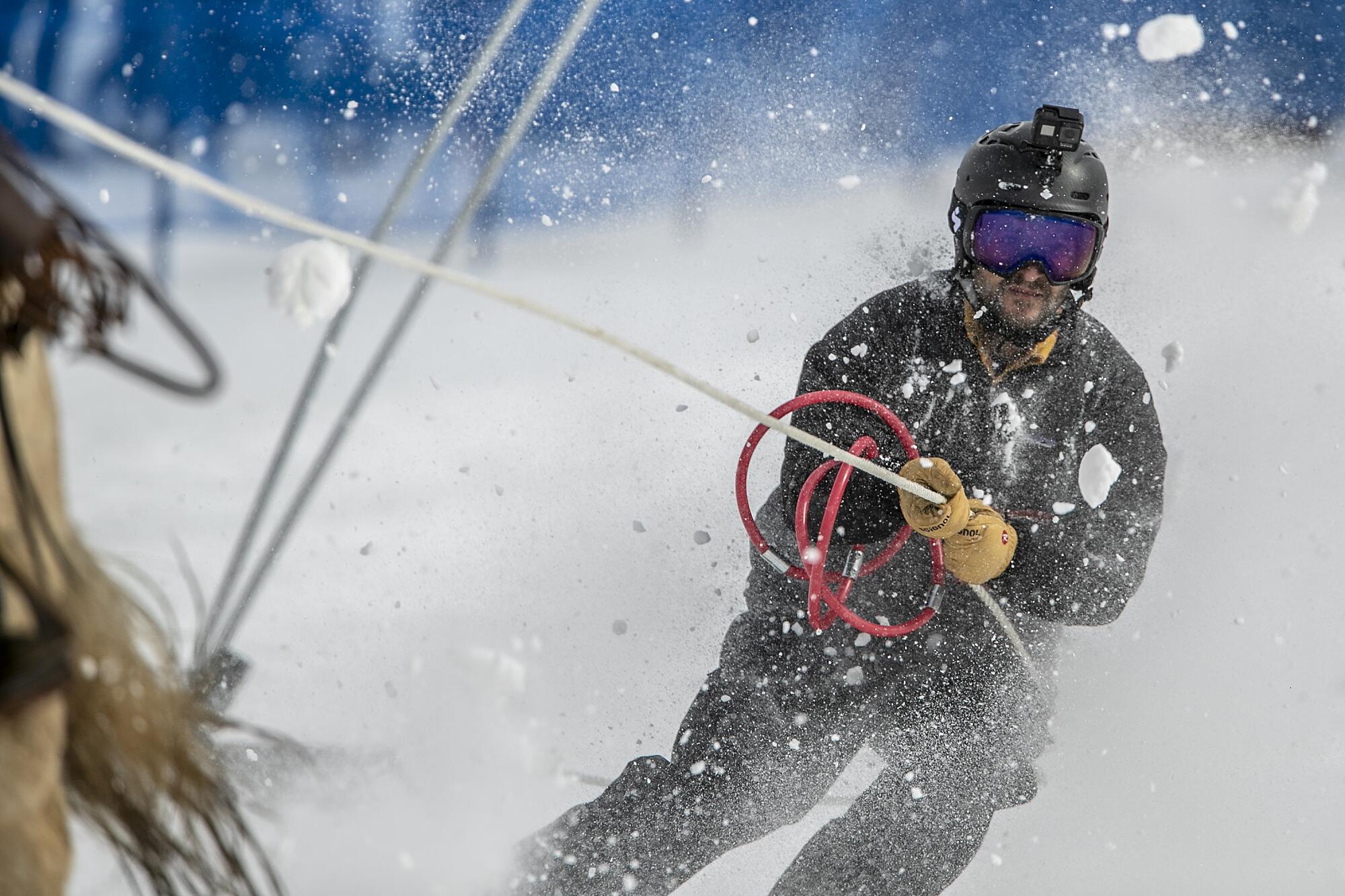
By 2000, the number of annual races had grown to 10 in several states. This season, there was a record 30 events, according to skijor.com, though lack of snow prompted the cancellation of many of the Montana races.
Skijor.com is a small New York-based alliance that oversees the sport in the U.S., attempting to bring some uniformity to courses and rules, while looking after horse and rider safety.
“It’s really good for towns,” says Loren Zhimanskova, who runs skijor.com. “It fills the hotels. … it’s definitely growing.”
Every track is different. Most are straightaways, though Montana organizers prefer a curved course. At the annual event in Leadville, Colo., competitors race 805 feet past shops and taverns in the heart of town, with three jumps and six rings along the way. Dating to 1949, Leadville is considered the Super Bowl of skijoring.
A look at athletes, coaches and others in the sports world who have tested positive of the coronavirus.
The season finished in early March, just under the wire for the coronavirus outbreak, though cowboys don’t quarantine easily. The finals in Red Lodge, Mont., went on as planned, March 14-15.
Of all the events, Utah is among the most technical — and quickest. Its fat, compacted snow base, a Nordic ski track on an ex-Olympic site, allows for more grip and faster runs.
Each year, Utah’s categories expand. There are now six, with a high school division, and one dubbed “century,” where the ages of the skier and rider must add up to 100 or more. Women have their own division, but also cross-compete with the men in the three primary divisions: novice, sport and pro.
A group of 127 runners has managed to participate in every edition of the Los Angeles Marathon since the race’s inception in 1986.
Utah, which began in 2017, is one of the newer skijoring events. Outsiders came to the inaugural competition, figuring to fleece a few thousand bucks in prize money from the rookies.
Dillon Flinders, a local mountain bike and ski race phenom, had different ideas. Then only 15, he stole the show and the first-place loot. He has won the pro category, the most competitive division, every year since.
Flinders is a study in strategic skijoring. Where others yo-yo from side to side, Flinders pulls on the rope, toward his horse, hand over hand like Hercules.
He says that by shortening the gap between him and the horse, he also shortens the distance to the finish line, gaining precious seconds. He is also pelted with chunks of ice and snow.
They have their reasons
The first question is why? Why risk your neck for a belt-buckle prize and a few thousand dollars?
Adrenaline, sure. Novelty? No doubt.
“It’s something new and different from what everyone else is doing,” says Troy Houston, 56, a skier who tries to compete in several events each season.
“It’s fast, it’s furious,” says Holland Howe, 20, a nursing student who is among the top female competitors.
“I’m from Montana,” she says with a shrug, as if that explains almost anything, including the hard crash she takes on Day Two of the Utah event.
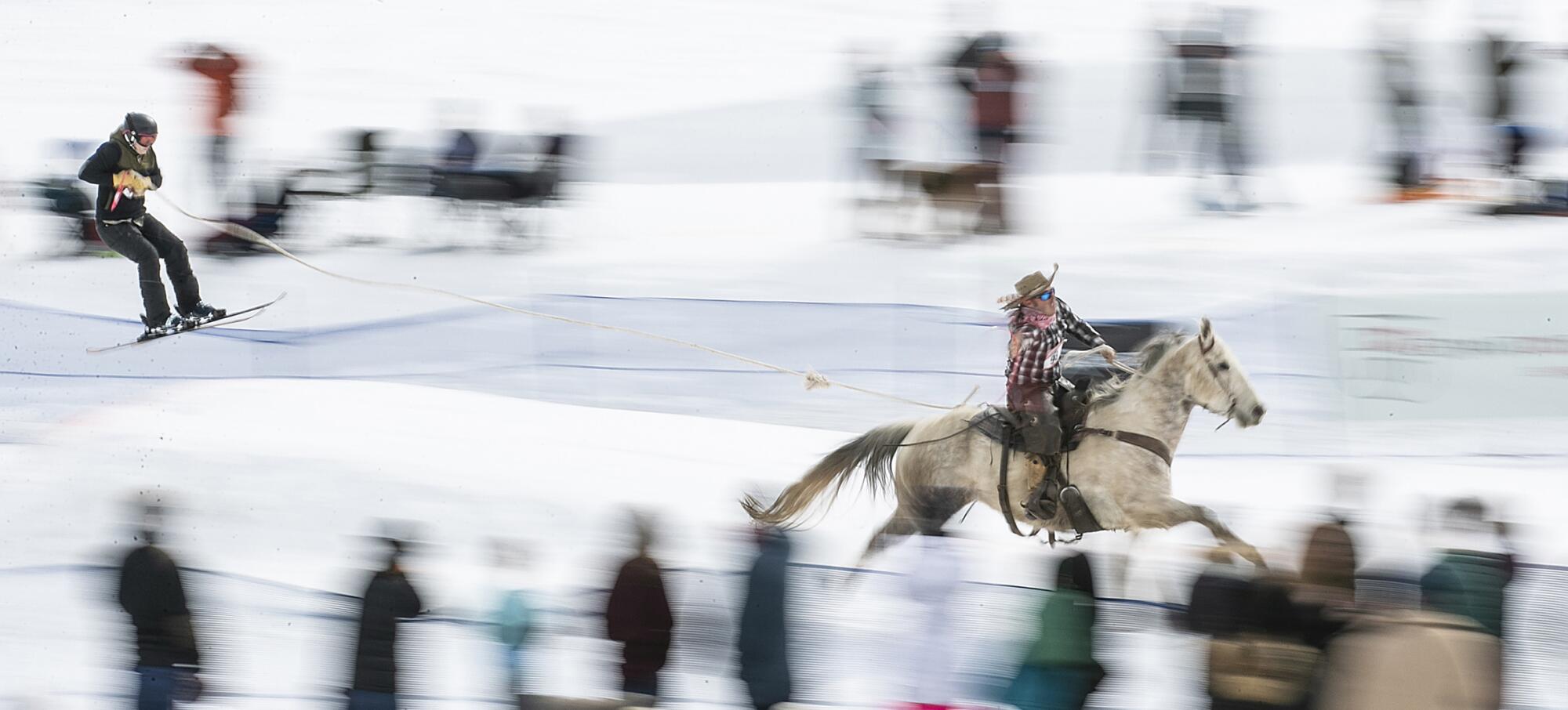
For the horses, it’s almost a winter pageant: rodeo horses (most of which are quarter horses), draft horses meant to pull wagons … a mule … even a clod-footed Clydesdale are on display here.
All of them are swift, but quarter horses are faster than thoroughbreds over a short distance. The Utah course is a relatively modest 450 feet, making the start vital. Out of the gate, the horses’ haunches seem to explode.
The animals wait near the starting line for their turns, stoic like their riders, brushed out, trimmed.
When it’s time to get into position, it’s as if they’ve hit the dance floor, all spin moves and drum-major kicks. Often, the rider needs to settle the horse before handing down the 30-foot rope to the skier, who is timed by a chip attached to a boot.
When the skier passes through two bales of hay, tripping the timing system, the race is on.
The racers shoot out of the gate, J-hook off a berm, and then punch their right arms through the first plastic ring, which they cradle in the crook of their arm to keep their hands free. Then boom, there’s a significant jump, maybe four-feet high. In the middle of that jump, the rider has to veer to one side to also snag a ring.
“I did a somersault when I fell, like you’re supposed to. I didn’t realize I tore my shoulder up for half an hour. The adrenaline out there ...”
— Chad Colarusso
This might be the time you start to wonder: Is this a sport or a bar bet?
And it’s not over yet. There are more gates, then a final jump before the skier jams a fist through a double ring at the finish.
Miss a ring or a gate? Subtract a second off your time. Lose the rope, you’re done.
“What’s the first rule of skijoring?” emcee Brian Tolbert prompts the crowd.
“Don’t let go of the rope!” the crowd screams.
‘It was a little icy ...’
Actually, the first rule of skijoring? Survival.
Chad Colarusso, 40, is stuck watching this year after blowing up his shoulder in last year’s race. The scorecard: seven screws and a plate, eight months to heal.
“It was a little icy. … I did a somersault when I fell, like you’re supposed to,” says Colarusso, who has a mustache like an armload of hay. “I didn’t realize I tore my shoulder up for half an hour. The adrenaline out there. ...”
At the starting line, every skier mentions that word: adrenaline. Thick in your throat, they say. Almost debilitating.
There are two movements to this winter symphony, the riders and the skiers (a few boarders participate too, but they don’t carve quite as well). The skiers are fairly accomplished, many with racing backgrounds. Quick-pivot turns, in icy conditions, are a must.
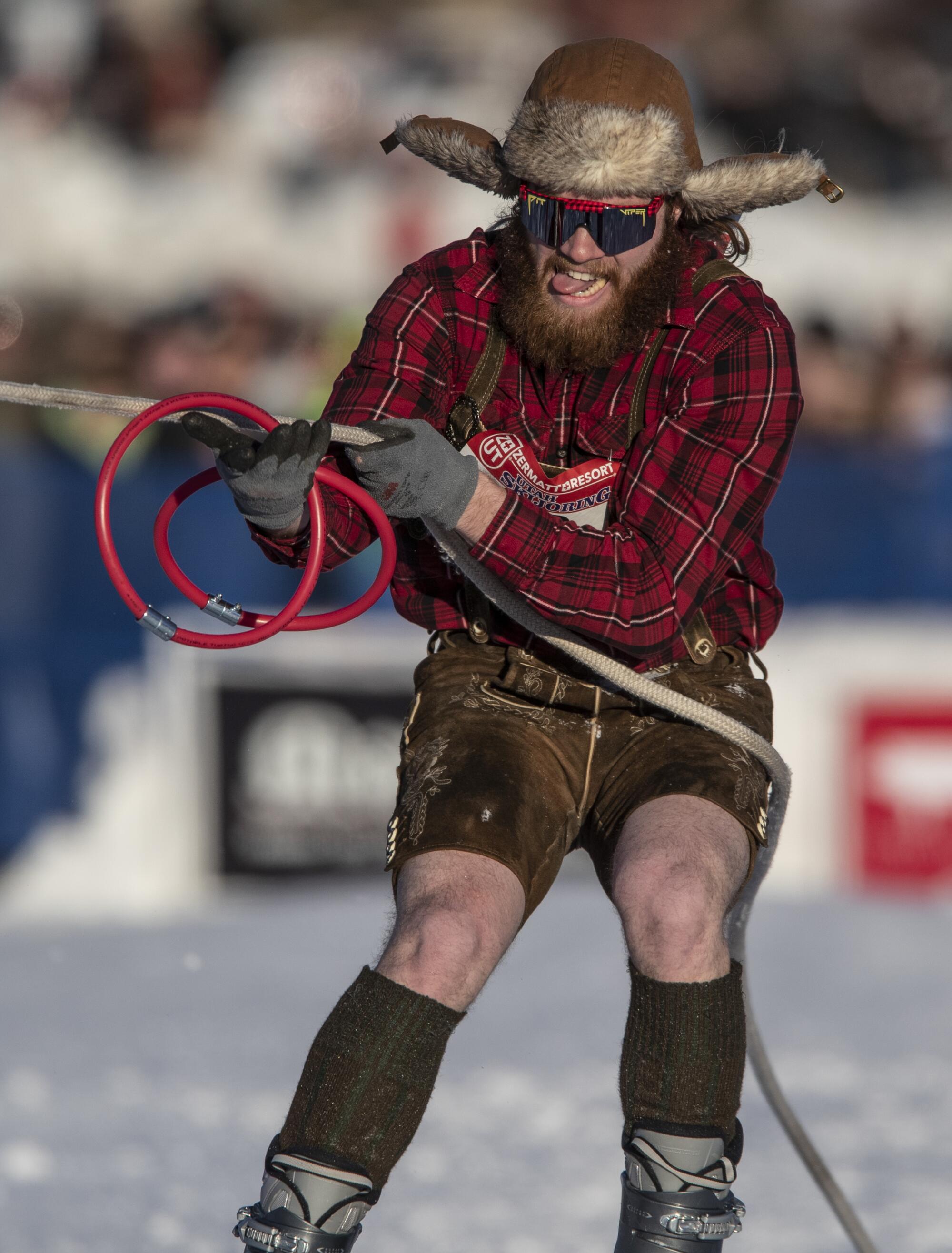
This is a collision of worlds: the relatively well-off skiers and the working-class ranch hands. Some rider-skier combos sign up together, others arrive as singles looking to form a team.
“We were talking at registration that you can tell the riders from the skiers just by looking at their shoes,” says skier Brandon Budge, 25.
“It’s the biggest clash of cultures,” adds skier Carl Budge, Brandon’s father.
The riders, many in chaps, tend to be terse Clint Eastwood knockoffs, tough as timber. … no whining allowed. The skiers are more animated, generally a little younger, pulling on IPAs before the race, a few final sips of courage — the first-timers more than most.
The start is critical, and during the late February event they’re all flipping out a little. Due to the whipsaw nature of it — the rings, the gates — the race is over in 15-20 seconds, about the time it takes to drink a glass of milk.
Among the participants ...
As with all sports, there are stories within the story.
Houston, who tests the skijoring circuit each season, is among the more devoted and experienced participants at the Utah event. The previous week, he’d won $500 in Pinedale, Wyo. Next year, he hopes to hit the race in West Yellowstone, Mont.; with a $10,000 top prize, it’s one of the most lucrative around.
For him, and others, it can be a profitable winter hobby; purses haven’t risen high enough to make this a full-time profession.
Major League Baseball teams agree to contribute $1 million each toward a fund that will assist ballpark workers during the suspended season.
In Utah, for example, the prizes are based on entry fees, and winners in the pro division split the top purse — about $7,000 — between rider, skier and horse owner.
Another micro-story in this two-day event is a tough, bantam-sized skier named Arne Eristyi.
Eristyi has made a name for himself here in Utah, based on a daredevil flip in last year’s event. Prompted by the emcee, the crowd chants his name when he passes.
Ar-NE! Ar-NE! Ar-NE!
Eristyi’s skinny, unfashionable skis look like yard-sale leftovers. Rumor has it that the high school shop teacher made them himself. He didn’t. But he likes the low-brow look.
“It’s the bottoms that count,” he says with a smile.
He is pulled by Krista Horting, a former student who is now Utah’s only female fire battalion chief. Together, they win the big-air competition, a showy spectacle of distance jumping separate from the skijoring racing.
At 62, Eristyi is still full-bore fast and entirely fearless. He flies 50 feet, crashing on both his attempts and rolling in the snow, bouncing to his feet, then crashing to the snow again.
“I thought we killed him,” Tolbert the emcee, recalls later. “I sprinted down, and all he wanted to know was how far he went.”
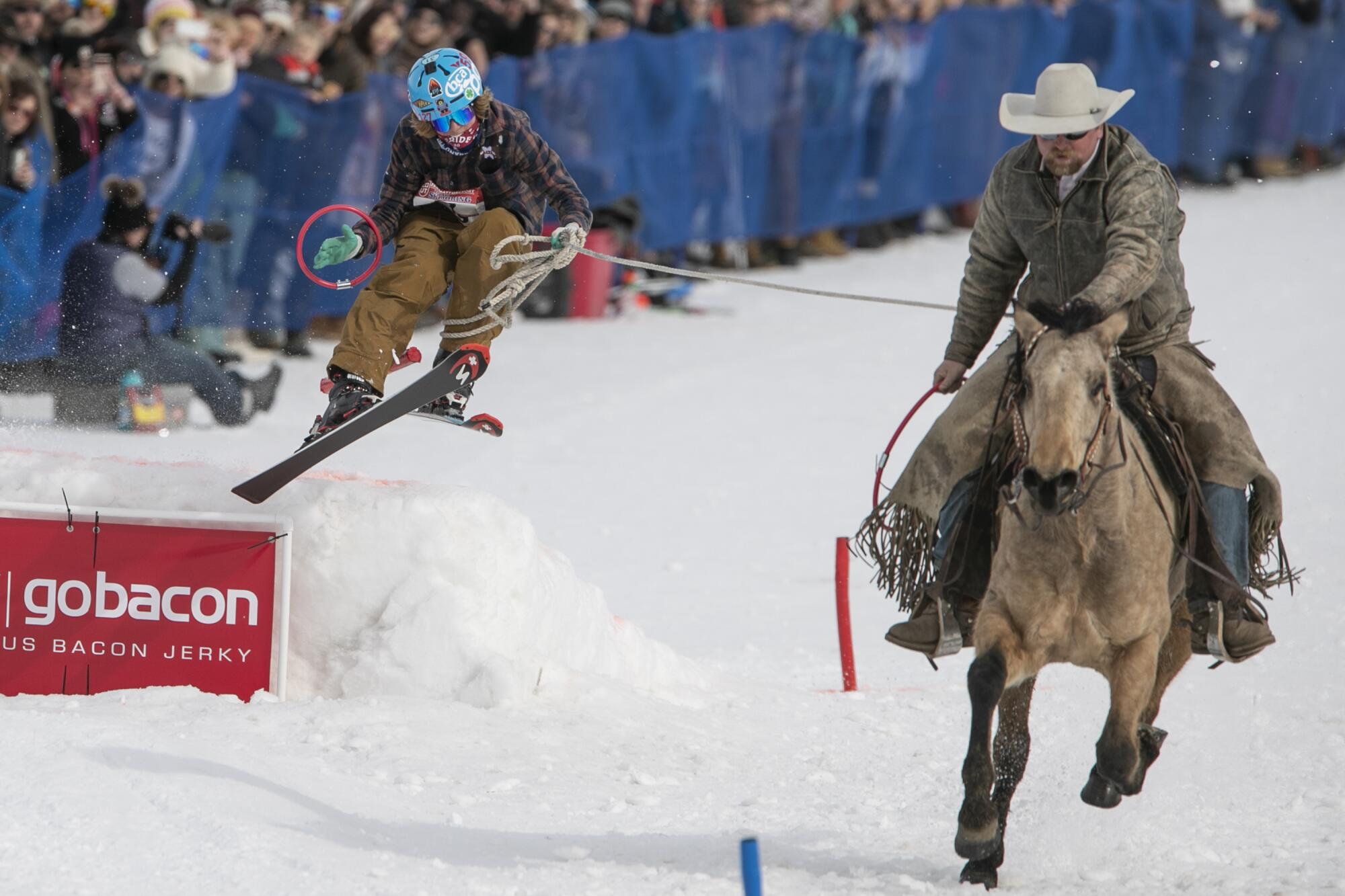
Perhaps the most compelling story of the weekend is that of horse owner Danielle Finger, of Sandy, Utah, who has multiple sclerorsis, a disease that is stealing her muscle control. Riding her horse Lute, a rare Norwegian Fjord bred for this kind of freezer-burn conditions, is part of her therapy and seeing her horse in action here gives her plenty of smiles.
Lute is being raced this weekend by her friends Franzi Wischmann (the rider) and her twin sister Ricki (on skis).
“I would’ve sold him, and gotten rid of him, like I had to with all my other horses, but he was so good to me,” says Finger, who says that Lute bends and adjusts so she can wiggle aboard.
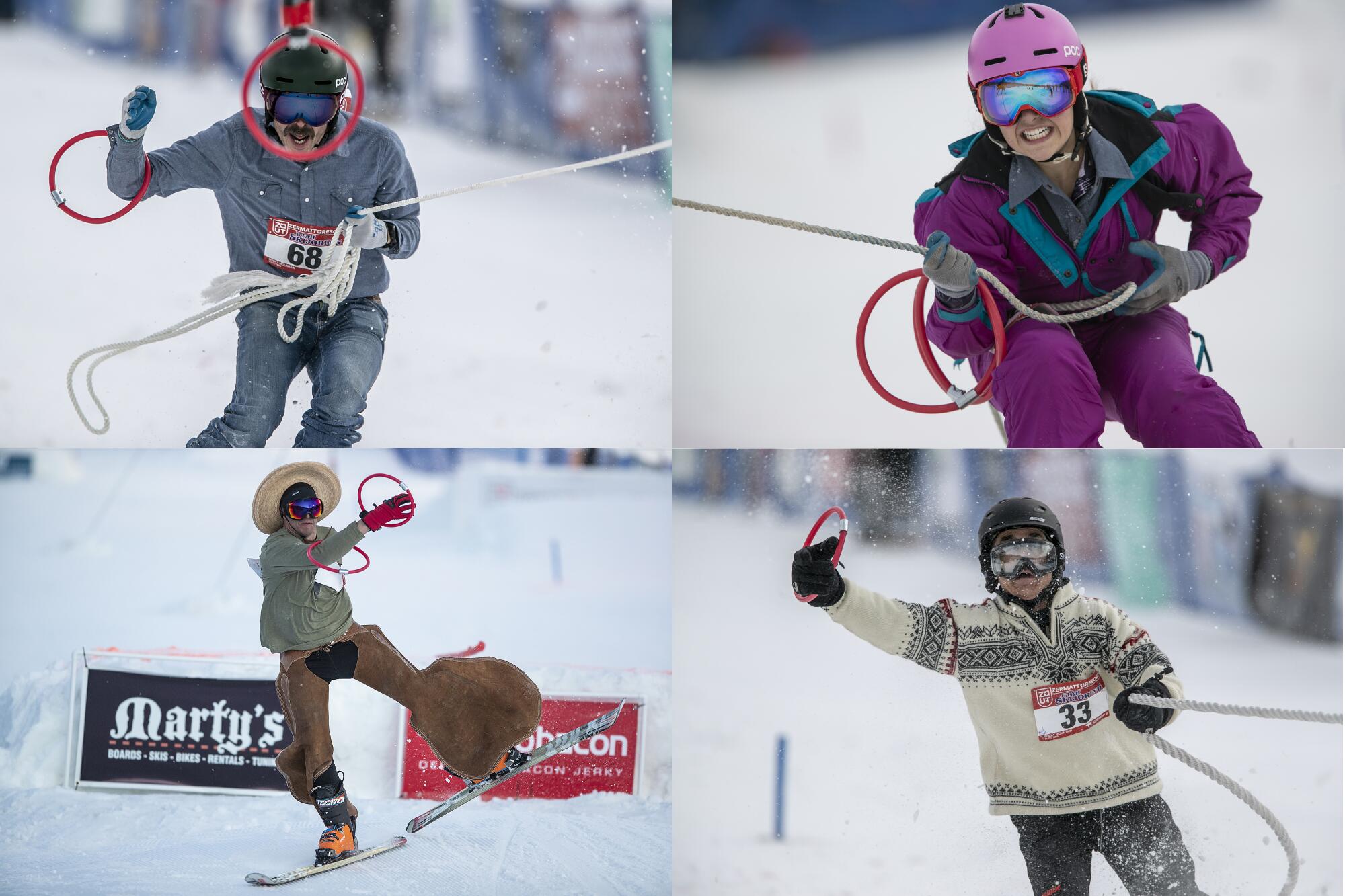
More sun than gloom
Like Finger, everyone has battled back and bounced up to their feet this weekend. There are no injuries of note, no horses going down. It’s a clean event. Organizers say athlete safety, equine and otherwise, is paramount.
“For me, a big part of it is the horsemanship,” says rider Trevor Howard. “With a horse, everything that’s going on in your head, goes right down to the horse.”
In the end, much of the draw is the chance to absorb a day outdoors.
At the start line, Eric Stonehill, 31, looks around at the horses, the riders, his burnished fellow skiers, and the snow-capped Wasatch Mountains that surround him like God’s good china.
“I’m a liberal Jew from the suburbs of D.C.,” Stonehill says.
“Here, it’s as if I’ve found America.”
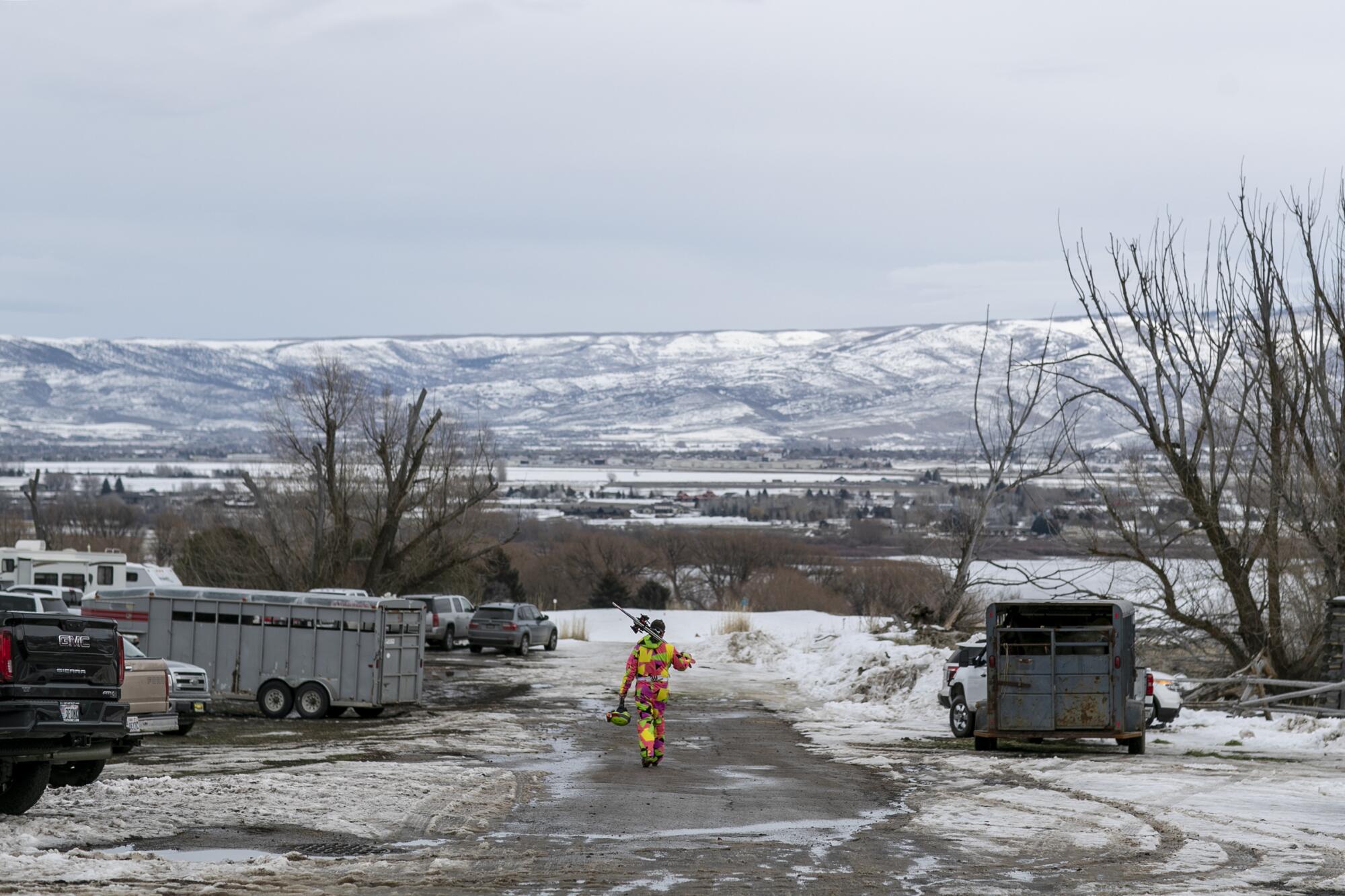
More to Read
Go beyond the scoreboard
Get the latest on L.A.'s teams in the daily Sports Report newsletter.
You may occasionally receive promotional content from the Los Angeles Times.



